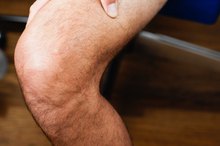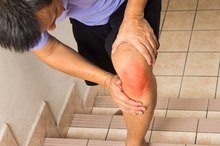What does fact checked mean?
At Healthfully, we strive to deliver objective content that is accurate and up-to-date. Our team periodically reviews articles in order to ensure content quality. The sources cited below consist of evidence from peer-reviewed journals, prominent medical organizations, academic associations, and government data.
- American Academy of Family Physicians: Knee Problems
- MayoClinic.com: Severe Bleeding: First Aid
- American Academy of Family Physicians: First Aid: Cuts, Scrapes and Stitches
The information contained on this site is for informational purposes only, and should not be used as a substitute for the advice of a professional health care provider. Please check with the appropriate physician regarding health questions and concerns. Although we strive to deliver accurate and up-to-date information, no guarantee to that effect is made.
How Do I Care for Knee Wounds?
Your knees are constantly moving, often taking the brunt of pressure and impact when kneeling or falling. Outside the knees is a fragile layer of skin tissue that can be cut or scraped. Inside the knees are more tissues that can be wounded, including muscle tissue and the osseous tissue of the bone surrounded by ligaments, tendons and cartilage. As such, knee wounds can present a challenge when approaching them for wound treatment.
If you are experiencing serious medical symptoms, seek emergency treatment immediately.
Address the Bleeding
Use a clean towel, washcloth or piece of gauze to place firm pressure on the wound. Keep the pressure on the wound until it completely stops bleeding. This may take 10 minutes or more. If the bleeding does not stop, the Mayo Clinic recommends placing another bandage or piece of clean material over the first to continue absorbing blood and placing direct pressure on the artery above the knee. If the bleeding still continues, seek medical help.
- Use a clean towel, washcloth or piece of gauze to place firm pressure on the wound.
- If the bleeding does not stop, the Mayo Clinic recommends placing another bandage or piece of clean material over the first to continue absorbing blood and placing direct pressure on the artery above the knee.
Clean the Wound
How to Treat a Deep Bone Bruise of the Knee
Learn More
Clean the wound thoroughly with mild soap and warm water. If possible, clean the wound using running water to help wash out any debris or dirt in the wound. Do this by putting your leg under a shower head--if the knee is not injured enough to be unable to stand.
Prevent Infection
Apply an over-the-counter antibiotic cream to the wound area, or pour hydrogen peroxide over the wound to help prevent infection. Cover the wound firmly with a clean gauze and wrap the knee in elastic bandage to keep dirt and other substances from getting into the wound.
Controlling Swelling
How to Care for a Bruised Knee
Learn More
Wrap an ice pack with a towel, and apply the ice to the knee for 15 to 20 minutes four times a day until the swelling subsides. Do not apply the ice directly to the knee without the towel. The body responds to your knee wound by flooding the affected area with white blood cells to help heal the knee. These blood cells can cause inflammation. Ice helps reduce inflammation as well as the pain associated with the injury.
- Wrap an ice pack with a towel, and apply the ice to the knee for 15 to 20 minutes four times a day until the swelling subsides.
Elevation
When the wound has been secured, elevate the knee by placing your leg on a pillow while lying down, or up on a chair when sitting if the wound allows you to place your leg straight. Rest the leg as much as possible, and keep the wound area clean and dry.
When to Call a Doctor
Call a doctor or seek medical attention if the bleeding will not stop, or if the knee does not feel right. For example, if you have unbearable pain, noticeable lumps, inability to place any pressure on the knee or if you suspect you may have broken your patella. If the knee wound is deep enough to where you cannot get the edges to stay together or if the edges look jagged, you may need stitches or a skin adhesive, according to the American Academy of Family Physicians 12.
- Call a doctor or seek medical attention if the bleeding will not stop, or if the knee does not feel right.
- If the knee wound is deep enough to where you cannot get the edges to stay together or if the edges look jagged, you may need stitches or a skin adhesive, according to the American Academy of Family Physicians 1.
Related Articles
References
- American Academy of Family Physicians: Knee Problems
- American Academy of Family Physicians: First Aid: Cuts, Scrapes and Stitches
- 3M Wound Resource Center. http://solutions.3m.co.uk/wps/portal/3M/en_GB/skin-care/wound-resource-centre/
- Mccaughan D, Sheard L, Cullum N, Dumville J, Chetter I. Patients' perceptions and experiences of living with a surgical wound healing by secondary intention: A qualitative study. Int J Nurs Stud. 2018;77:29-38. doi:10.1016/j.ijnurstu.2017.09.015
- Krafts KP. Tissue repair: The hidden drama. Organogenesis. 2010;6(4):225-33. doi:10.4161/org.6.4.12555
- Chetter IC, Oswald AV, Fletcher M, Dumville JC, Cullum NA. A survey of patients with surgical wounds healing by secondary intention; an assessment of prevalence, aetiology, duration and management. J Tissue Viability. 2017;26(2):103-107. doi:10.1016/j.jtv.2016.12.004
- Singh PK, Saxena N, Poddar D, et al. Comparative Study Of Wound Healing In Primary Versus Delayed Primary Closure In Contaminated Abdominal Surgery. Hellenic J Surg. 2016;88:314–320. doi:10.1007/s13126-016-0340-8
- Surgical Patient Education Program: Prepare for the Best Recovery. American College of Surgeons. 2018.
- Rushbrook JL, White G, Kidger L, Marsh P, Taggart TF. The antibacterial effect of 2-octyl cyanoacrylate (Dermabond®) skin adhesive. J Infect Prev. 2014;15(6):236-239. doi:10.1177/1757177414551562
- Lazar HL, Mccann J, Fitzgerald CA, Cabral HJ. Adhesive strips versus subcuticular suture for mediansternotomy wound closure. J Card Surg. 2011;26(4):344-7. doi:10.1111/j.1540-8191.2011.01257.x
- 3M Wound Resource Center.
Writer Bio
Chris Sherwood is a professional journalist who after years in the health administration field and writing health and wellness articles turned towards organic sustainable gardening and food education. He now owns and operates an organic-method small farm focusing his research and writing on both organic gardening methods and hydroponics.







